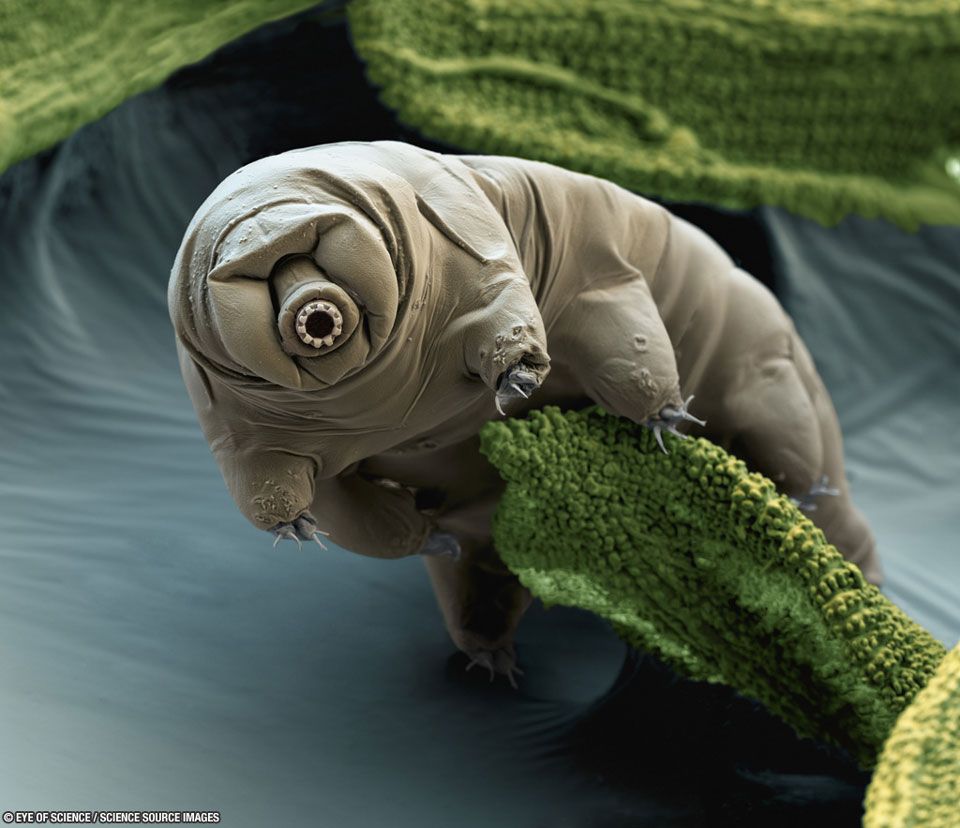The DU Lounge
Related: Culture Forums, Support Forums50 Unbelievable Facts About The Earth!
http://mightymega.com/2013/04/18/infographic-50-unbelievable-facts-about-earth/frogmarch
(12,152 posts)*From here & there on the net: Tardigrades (also called water-bears or moss piglets) are the hardiest animals known to exist on Earth. Pictured in the color-enhanced electron micrograph, a millimeter-long tardigrade crawls on moss.

*Wiki: "Tardigrades are notable for being one of the most complex of all known polyextremophiles. An extremophile is an organism that can thrive in a physically or geochemically extreme condition that would be detrimental to most life on Earth For example, tardigrades can withstand temperatures from just above absolute zero to well above the boiling point of water, pressures about 6 times stronger than pressures found in the deepest ocean trenches, ionizing radiation at doses hundreds of times higher than would kill a person, and the vacuum of outer space. They can go without food or water for nearly 120 years, drying out to the point where they are 3% or less water, only to rehydrate, forage, and reproduce."*
*APOD (Astronomy Picture of the Day): "They can survive direct exposure to dangerous radiations. The far-ranging survivability of these extremophiles was tested in 2011 outside an orbiting space shuttle. Tardigrades are so durable partly because they can repair their own DNA and reduce their body water content to a few percent. Some of these miniature water-bears almost became extraterrestrials recently when they were launched toward to the Martian moon Phobos on board the Russian mission Fobos-Grunt, but stayed terrestrial when a rocket failed and the capsule remained in Earth orbit. Tardigrades are more common than humans across most of the Earth."*
They're only 0.03937007874 of an inch long. Awww.
Enthusiast
(50,983 posts)NewJeffCT
(56,828 posts)I was reading about them recently.
cliffordu
(30,994 posts)Tardigrade overlords.
diverdownjt
(700 posts)A Simple Game
(9,214 posts)jakeXT
(10,575 posts)Within seconds the reduced pressure would cause the nitrogen which is dissolved in the blood to form gaseous bubbles, a painful condition known to divers as "the bends." Direct exposure to the sun's ultraviolet radiation would also cause a severe sunburn to any unprotected skin. Heat does not transfer out of the body very rapidly in the absence of a medium such as air or water, so freezing to death is not an immediate risk in outer space despite the extreme cold.
For about ten full seconds-- a long time to be loitering in space without protection-- an average human would be rather uncomfortable, but they would still have their wits about them. Depending on the nature of the decompression, this may give a victim sufficient time to take measures to save their own life. But this period of "useful consciousness" would wane as the effects of brain asphyxiation begin to set in. In the absence of air pressure the gas exchange of the lungs works in reverse, dumping oxygen out of the blood and accelerating the oxygen-starved state known as hypoxia. After about ten seconds a victim will experience loss of vision and impaired judgement, and the cooling effect of evaporation will lower the temperature in the victim's mouth and nose to near-freezing. Unconsciousness and convulsions would follow several seconds later, and a blue discoloration of the skin called cyanosis would become evident.
At this point the victim would be floating in a blue, bloated, unresponsive stupor, but their brain would remain undamaged and their heart would continue to beat. If pressurized oxygen is administered within about one and a half minutes, a person in such a state is likely make a complete recovery with only minor injuries, though the hypoxia-induced blindness may not pass for some time. Without intervention in those first ninety seconds, the blood pressure would fall sufficiently that the blood itself would begin to boil, and the heart would stop beating. There are no recorded instances of successful resuscitation beyond that threshold.
Though an unprotected human would not long survive in the clutches of outer space, it is remarkable that survival times can be measured in minutes rather than seconds, and that one could endure such an inhospitable environment for almost two minutes without suffering any irreversible damage. The human body is indeed a resilient machine.
http://www.damninteresting.com/outer-space-exposure/
tjwmason
(14,819 posts)I thought it would be a few seconds at the highest.
Wait Wut
(8,492 posts)The time in space a human can survive in space unprotected.
FUCK THAT!!! Put 'space' on my list of places I will never, ever go...not even with a free ticket and promises of unicorns. 2 minutes. That's a long time to not be able to friggin' scream.
love_katz
(2,578 posts)NJCher
(35,600 posts)Humans: the least worthy of all species on the planet.

Cher